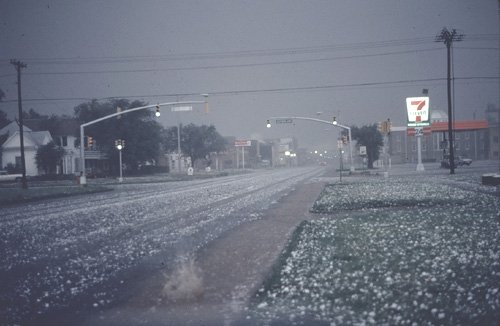Compared to hurricanes or winter storms, a thunderstorm is relatively small. The typical thunderstorm is about 15 miles in diameter and generally lasts about 30 minutes. However, despite their small size, all thunderstorms are potentially dangerous. When a thunderstorm reaches "severe" limits, it has intensified to the point that it will produce wind gusts of at least 58 mph and/or hail 1 inch in diameter (about the size of a quarter) or larger. 
Georgia's peak severe thunderstorm season is March, April and May. A secondary peak may occur during the months of September and October, but not always. Severe thunderstorms can, and do, occur at anytime of the day or night as well as any month of the year.
| Hail Size Chart | |
|---|---|
| Pea | 0.25" |
| Penny/Dime | 0.75" |
| Quarter | 1.00" |
| Half Dollar | 1.25" |
| Golfball | 1.75" |
| Tennis Ball | 2.50" |
| Baseball | 2.75" |
| Grapefruit | 4.00" |
When a SEVERE THUNDERSTORM WARNING is issued, large hail may pelt you, your home, your pets, and your property. These warnings are issued when a severe thunderstorm is indicated by radar, or reported by a reliable source. You should move to a safe place immediately. If time permits, consider moving vehicles into sheltered areas (garages, carports, etc.) and provide shelter for pets.
IF SEVERE WEATHER OCCURS IN YOUR AREA: remain in safe shelter until the storms have passed. Once it is safe to leave the shelter, report any severe weather, such as a tornado, or hail the size of dimes or larger, or wind damage such as snapped power lines, fallen trees or roof damage to your local National Weather Service or contact your local law enforcement agency and ask them to relay thcleare information to the National Weather Service.